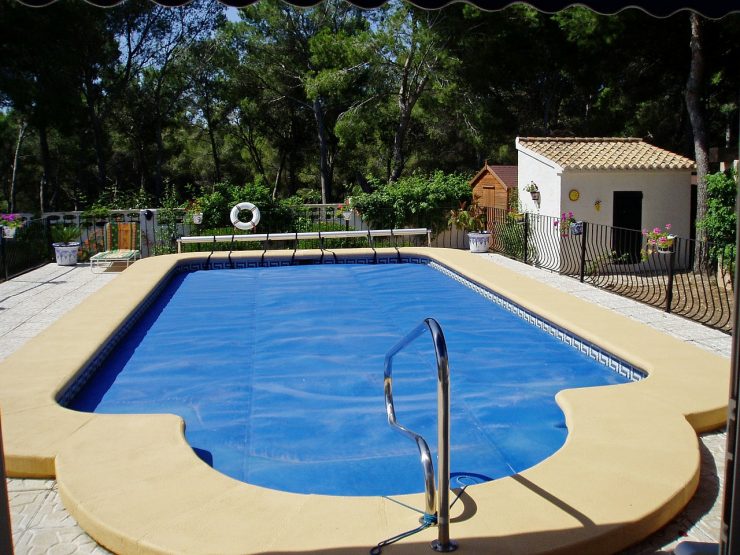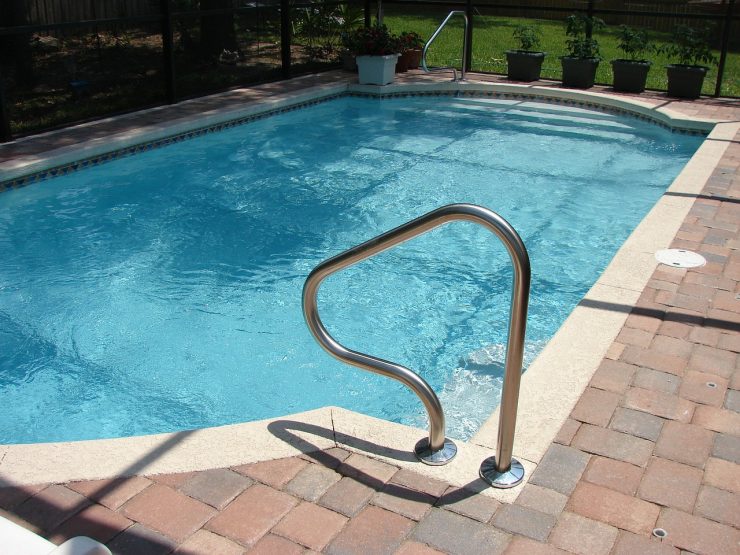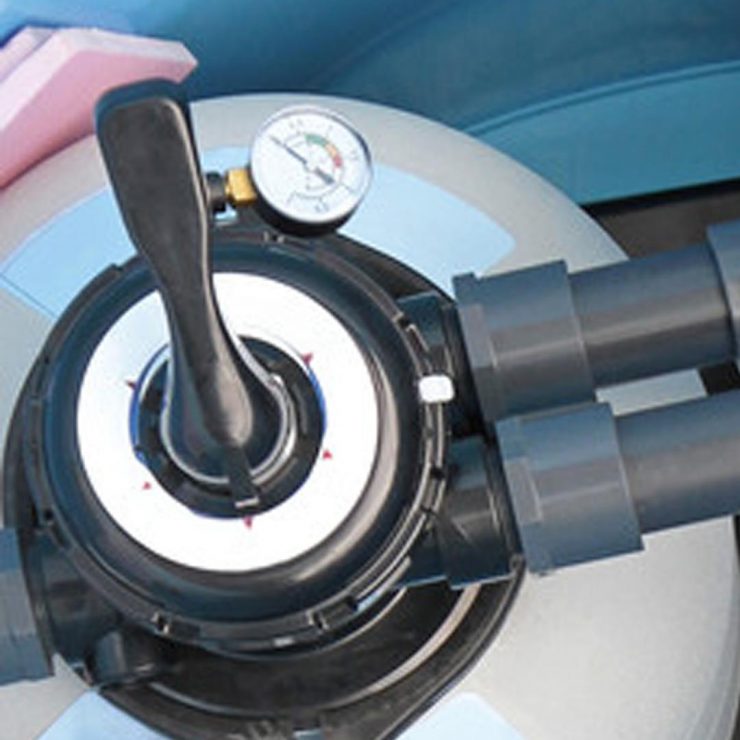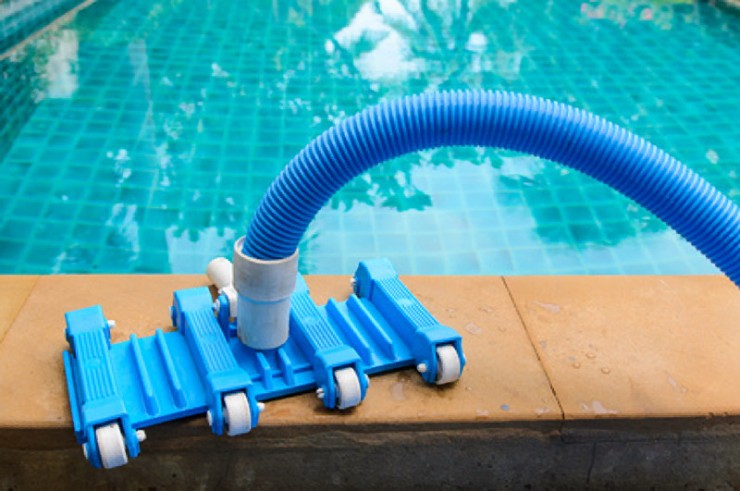The weather is heating up and it’s time to open your inground pool. If you are new to opening a pool for the summer, this is for you. We show you how to easily open your inground pool so you can dive into the swimming season. Let’s get started!

By the way, if you have an above ground pool, head over to our article on how to open an above ground swimming pool.
Article Contents
Things You Will Need
A helper
Swimming Pool Net (skimmer net)
Pool Cover Pump (submersible pump)
Start-up chemical kit or your basic pool chemicals including chlorine
1. Clean Debris And Drain Water From Pool Cover
Safety covers and or pool covers will need to be cleared of both winter debris and any accumulation of water sitting on the cover.
Use a pool brush and net to remove it. Be careful not to use sharp tools such as metal rakes to avoid damaging your pool cover.
The best way to eliminate the accumulation of water is to use a submersible pool cover pump or sump pump. Or you can scoop the water with a bucket… but doing it this way can be a slooow process.
Do this now and it will mean less work later when it comes to cleaning your pool.
2. Take Off the Pool Cover And Clean It

By carefully removing the winter pool cover, you can minimize further debris entering the pool. It’s much easier if you have a friend to help you.
Once the pool cover has been removed, find a location big enough to lay it out so you can clean it. Next, apply pool cover cleaner or a mild detergent and use your pool brush to gently clean the dirt from the pool cover.
After that, leave the pool cover to dry completely before folding and storing it for the summer season.
A large waterproof storage box is a really good storage solution. If not, insects or rodents may take a liking to your pool cover and make it their home.
3. Remove Winter Plugs And Ice Compensators
Go ahead and remove the plugs you put in at closing time from return lines, the openings, including skimmer basket and return jets, also called eyeball fittings.
Remove ice compensators from the skimmer. Equipment such as the skimmer can crack over winter if the water freezes. An ice compensator, freeze plug or Gizzmo prevents this.
At this stage, all other winterizing equipment can be removed from the swimming pool too.
If you used antifreeze in your pool, you’ll need to blow out all the pipes. Did you use the correct antifreeze? Find out here: Is RV Antifreeze OK for a Swimming Pool? (Answered!)
4. Add Water

If the water level is low or you reduced the water level as part of your pool winterisation, now is the time to fill the pool with water. Use a garden hose and refill the pool water to mid skimmer level.
5. Pool Pump & Equipment Set-Up
Now it’s time to set up your swimming pool equipment.
Put the drain plugs back into your pump and filter. Use thread seal tape to make sure there are no leaks. Put back any other gauges and drains that were removed.
Next attach the hoses by connecting the skimmer to the pump, the pump to the pool filter and then the filter to other equipment such as the chlorinator or your heater. In addition, if you do have a chlorinator, first connect the heater, then chlorinator and then return inlet. If there is no additional equipment, connect the hose to the return inlet.
Check the condition of the pump’s O-ring. You’re looking for any cracks or brittleness. And if you see evidence of deterioration, you should go ahead and replace the O-ring. Otherwise, lubricate it well with a Teflon-based lubricant and refit it.

Set the multiport valve to waste. Turn the pump on and let it run for about a minute. This is especially important if antifreeze was used when you closed the pool. Most of the antifreeze will run out during this process. It’s not a big problem if some antifreeze gets into the pool (providing you used the antifreeze for pools).
Now set the multiport valve to the filter position.
Start the pump. Next, listen for anything unusual and check for damage during the winter. Additionally, make sure the pressure gauge isn’t running overly high for long.
If the pump is running dry, turn the system off and prime the pump. To do this, remove the pump lid, add some water, close the lid and turn the pump on again.
Now is a good time to look at your filter too. If you have a cartridge filter, remove it and either wash it out or replace it.
Leave the pump running and the multiport valve in the filter position.
Great Job! You have now opened your inground pool!
6. Clean Your Swimming Pool

Remove debris with your skimmer or leaf rake.
Brush down the sides of your pool with your pool brush.
Vacuum the pool.
Related reading: How to Vacuum a Pool With a Filter or a Pump.
7. Adjust the Pool Water Chemistry
Use your pool test strips or pool water testing kit to check the levels of pool water chemicals.
The ideal readings you are looking for are alkalinity (100-150ppm), pH (7.4-7.6), and calcium hardness (200-275ppm). Add chemicals as necessary to bring the levels to the correct range.
Additionally, it’s also a good idea to add a metal sequestrant. Over winter metals can increase. This product will help prevent staining of the pool walls.
There is a specific order you should be adding the chemicals in. We have a full article on that here: What Order Should You Add Pool Chemicals?
8. Shock Your Pool
After a winter of hibernation, pool water should be shocked to sanitize the water.
We recommend this Pool Shock.
The ideal time to shock your pool is in the evening so the sun doesn’t use all the chlorine before it has had a chance to do its job.
Run the filter for 24 hours, test the water again to make sure the right water balance has been achieved. If the water is balanced, get your swimmers on and pool inflatables ready.
Related reading: How To Shock Your Pool.
Conclusion
Success! You have now opened your inground pool for the season. Your pool water will be clean, clear and ready for the swimming season. Did you get those pool floats ready? Great, now you can go relax in the pool.
Related Reading: Limestone VS Travertine For Pool Decks And Coping
Recommended Products
Swimming Pool Scoop Net or Rack
Gizzmo – Help prevent pool water freezing during winter.
Teflon-based Pool Lubricant – to lubricate the pumps O-ring.
Water Testing Strips or Liquid Water Testing Kit – check your water chemical balance.
Shock Treatment – ensure pool water is correctly sanitized with shock treatment.
You might be interested in:


